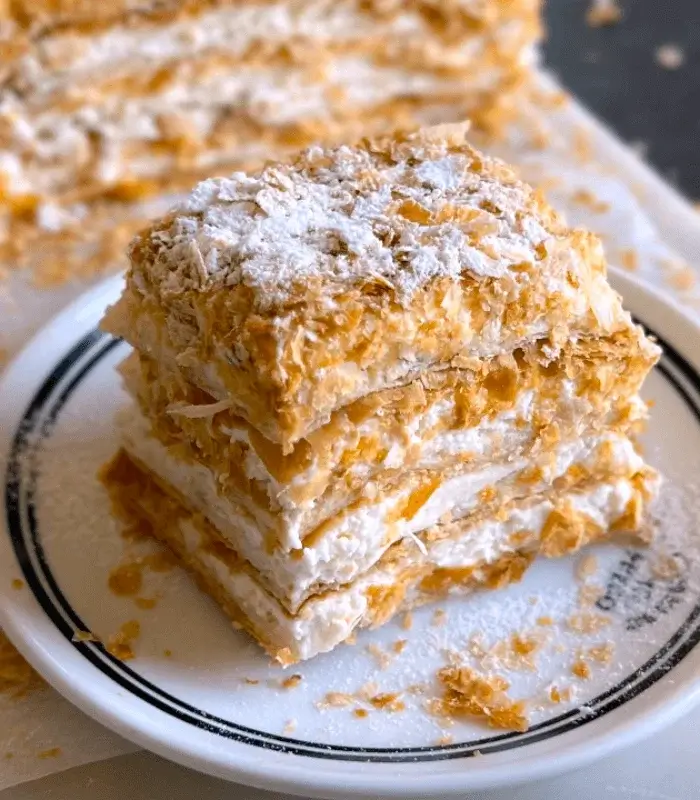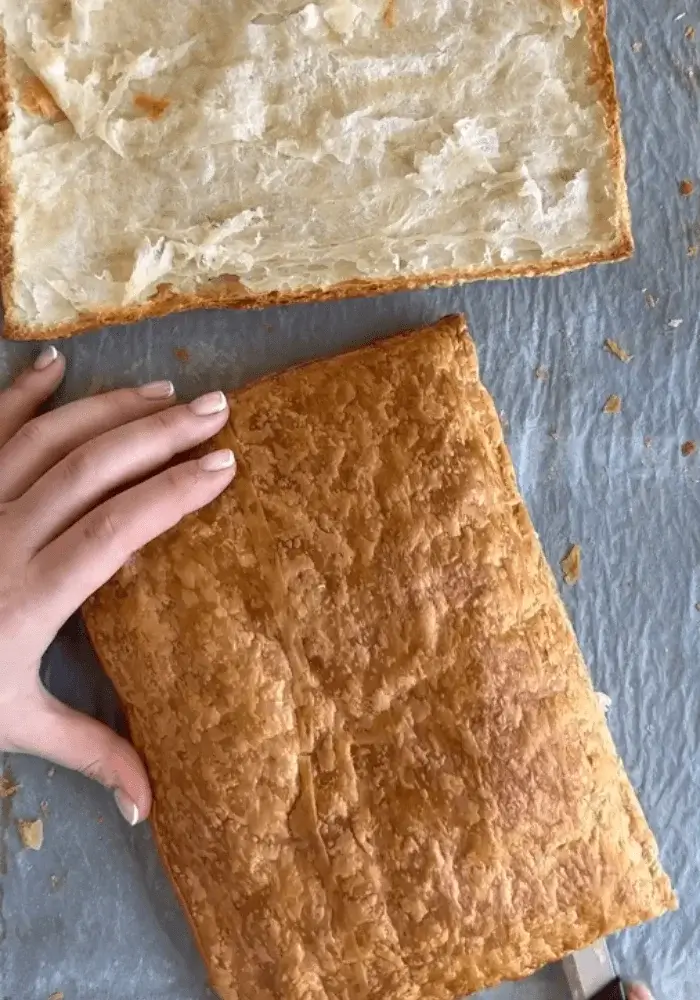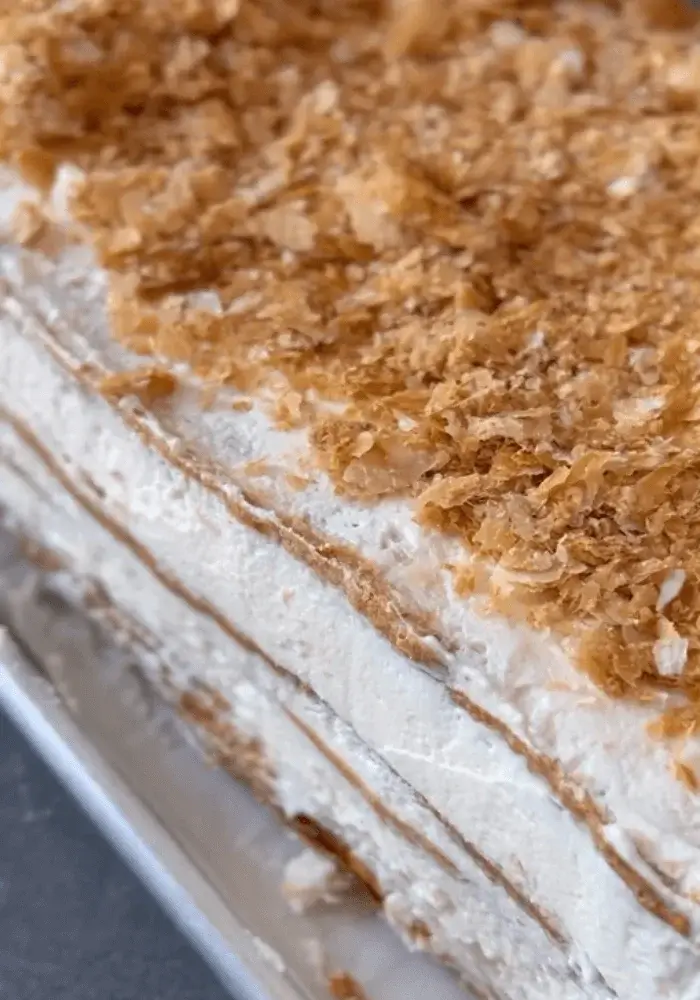The Ultimate Cremeschnitte Recipe for the Weekend
We may earn a commission from recommended products, at no extra cost to you. See Disclosure.
INGREDIENTS
- 18 ounces/500 grams puff pastry, thawed according to package instructions
- ¼ cup powdered sugar, for garnish
Filling:
- 3 cups/750 milliliters heavy cream
- 1 cup/240 milliliters whole milk
- 3.4 ounces/96 grams instant vanilla pudding mix
- ½ cup/100 grams granulated sugar
INSTRUCTIONS
- Preheat the oven to 355°F (180°C) with a convection setting. Roll out the puff pastry on a lightly floured surface and cut it into two even rectangles. Transfer the rectangles to a parchment-lined baking sheet and bake for about 30 minutes, or until deeply golden and crisp. Bake any leftover scraps separately—they will be used for garnish. Remove from the oven and let cool completely for 30 to 60 minutes. Once cooled, carefully slice each rectangle in half horizontally to create four layers.
- In the bowl of a stand mixer fitted with the whisk attachment, beat the heavy cream, milk, pudding mix, and sugar until stiff peaks form.
- Place one puff pastry layer on a serving platter. Spread a quarter of the cream mixture evenly over the pastry. Repeat the layering process, finishing with a layer of cream on top. Use an offset spatula to coat the sides of the cake with the remaining cream, smoothing it out for a clean finish.
- Crumble the baked pastry scraps and sprinkle them over the top. Refrigerate for at least four hours to allow the cream to set. Before serving, dust generously with powdered sugar.

FAQ
What is the origin of the cremeschnitte recipe?
The cremeschnitte recipe has its roots in Central and Eastern Europe, particularly in Austria, Hungary, Poland, and the former Yugoslavia. The name “cremeschnitte” comes from German, meaning “cream slice.” It is closely related to the French mille-feuille but differs in its simplicity, typically featuring fewer layers and a more generous amount of cream filling. Each country has slight variations in ingredients and presentation. In Poland, it is known as kremówka, while in Slovenia and Croatia, it is called kremna rezina. Despite regional differences, the core elements of the cremeschnitte recipe—flaky puff pastry and a rich vanilla cream—remain consistent.

Can I make a cremeschnitte recipe ahead of time?
Cremeschnitte can be made ahead of time, but it is best enjoyed within 24 hours of assembly. The pastry needs time to absorb the moisture from the cream filling, which helps the layers hold together. However, if left too long, the pastry may become overly soft. To prepare in advance, bake the puff pastry layers up to two days ahead and store them in an airtight container at room temperature. The cream filling can be made a day before and kept refrigerated. Assemble the dessert a few hours before serving and let it chill for at least four hours.
What type of puff pastry works best for cremeschnitte?
A high-quality, all-butter puff pastry is best for cremeschnitte. Butter-based puff pastry provides the richest flavor and crispiest texture compared to versions made with vegetable shortening. If using frozen puff pastry, ensure it is fully thawed before rolling it out to prevent cracking. Some bakers prefer making homemade puff pastry for an even flakier result, but store-bought options work well for convenience. Regardless of the brand, baking the pastry until it is deeply golden brown and allowing it to cool completely before slicing is essential to achieving the right texture in a cremeschnitte recipe.
How do I prevent the puff pastry from becoming soggy?
To prevent soggy puff pastry, start by baking the pastry until it is thoroughly golden brown and crisp. Underbaked pastry layers will soften too quickly when combined with the cream filling. Let the baked pastry cool completely before assembling to avoid trapping steam, which can lead to sogginess. If extra protection is needed, lightly dust the pastry with powdered sugar before adding the cream, as sugar can help create a barrier. Additionally, assembling the cremeschnitte recipe shortly before serving and refrigerating it for only a few hours ensures the best balance of crisp pastry and creamy filling.

What is the best way to cut the cake?
To cut the cake cleanly without squishing the layers, use a sharp, serrated knife and a gentle sawing motion. Chilling the dessert for at least four hours before slicing helps the cream filling set, reducing the risk of it oozing out. For extra precision, some bakers recommend freezing the cremeschnitte for about 15 minutes before cutting. A long, thin knife works best, and dipping the blade in hot water and wiping it dry between cuts can further ensure smooth slices. Avoid pressing down too hard, as this can cause the cream to spill out and distort the layers.
Can I add fruit or other flavors to this cremeschnitte recipe?
Yes, fruit and other flavors can be added for variation. Fresh berries, sliced bananas, or caramelized apples can be layered between the cream filling for added flavor and texture. Some recipes incorporate a thin layer of fruit preserves or a drizzle of chocolate ganache for extra richness. Citrus zest, almond extract, or rum can be mixed into the cream filling to enhance the taste. While traditional cremeschnitte is made with vanilla-flavored cream, adding complementary flavors can create a unique twist while maintaining the classic structure of the dessert.
Is there a way to make this cremeschnitte recipe gluten-free?
You can make this recipe gluten-free by using gluten-free puff pastry, which is available in specialty stores or can be homemade with gluten-free flour blends. The cream filling is naturally gluten-free, but always check the ingredients in instant pudding mixes or make homemade pastry cream to ensure no gluten-containing additives are present. When baking gluten-free puff pastry, it may require slightly different handling, as it can be more fragile than traditional pastry. Cooling and assembling the dessert carefully helps maintain its structure.

